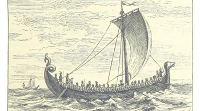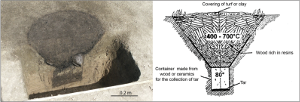|
Tar Fueled Viking Expansion, Study Says
November 6, 2018
A new theory is taking shape of why the Vikings were so successful at raiding and settling places far from their homes. The reason: tar. The Vikings' homelands, in and around Scandinavia, are already well-known as the sources of innovation in ship design and navigation techniques. What is also already known is that such large ships needed tar to keep them seaworthy, not just in the wooden framework but also in the wool sails. Now, in a study done by Uppsala University archaeologist Andreas Hennius, the story can be told: that the Vikings engaged on tar production on a mass production scale. Archaeologists have previously unearthed some tar kilns, in central Sweden, that date to the first few centuries A.D. Those were small and deemed for household use. Another dig, in 2005 in the northern party of the country, found larger kilns that date to the 7th–10th centuries A.D., when the Vikings grew to a world-beating powerhouse. In addition, the larger kilns were close to forests of pine trees, which were used in making tar. The lack of villages or gravesites convinced archaeologists that the larger kilns played a part in the industrial production of tar. The connection that Hennius has made is from this large-scale production of tar to the use of tar in shipbuilding and ship maintenance. The innovation described by Hennius in his study is the method that the Vikings used to make their tar. The Viking tar pits were funnel-shaped, as were tar pits found later elsewhere in Europe. However, archaeologists found evidence that the Vikings placed at the bottom of those funnel-shaped pits a wood or ceramic container designed to store the drippings from piles of wood that were burned under a layer of clay and charcoal. Research has shown that each of these pits could produce up to 80 gallons of tar at a time. That's nearly enough to produce one longship, the study said. Further evidence of large-scale tar production can be found in the remains of Viking tar barrels in Germany, the study said. The study appears in the latest issue of Antiquity. |
Social Studies for Kids |
Social Studies for Kids
copyright 2002–2019
David White






